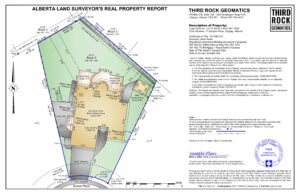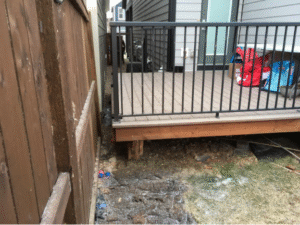Because retaining walls sit at the intersection of boundary, safety, and support, they’re one of the fuzzier features in residential real estate.
Clients often ask, “Is this wall shared?” And the honest answer is, it depends — on location, purpose, past agreements, and the common‑law duty to support land.

Why Retaining Walls Are Tricky
A retaining wall does not establish a property line. Boundaries are determined by land titles and surveys, not by where a wall happens to sit.
Calling a wall “shared” can also be misleading. Unlike party fences built on a boundary, retaining walls are usually tied to the parcel that benefits from the support they provide — often the parcel with a raised or altered grade.
Only clear evidence, such as a written agreement, joint construction records, or a wall intentionally located on the boundary for mutual benefit, justifies treating a wall as shared.
Ownership Vs. Responsibility
If a wall lies entirely on one parcel and holds back that owner’s higher or modified grade, responsibility commonly follows the benefit and control of that owner.
If the wall straddles the boundary or both owners clearly rely on it, evidence is required before concluding ownership and maintenance.
Where a wall encroaches onto a neighbour’s land, the remedies are situational: removal, a negotiated solution, or an encroachment order or agreement — each guided by impact, intent, hardship, and documentation.
The Common-Law Backbone: The Right of Lateral Support
Courts have long protected the right of land, in its natural state, to lateral support from adjoining land. Here are two widely cited cases you can reference to see how this has played out in common law:
- Dalton v. Angus & Co. (House of Lords, 1881). This leading case articulates the right of lateral support for land in its natural condition and limits a neighbour’s ability to withdraw that support. See Dalton v. Angus & Co.
- Reid v. Linnell (1923 SCC). A Canadian Supreme Court decision affirming the common-law right of land, in its natural state, to lateral support from adjoining land. The Court accepted that excavation which deprives a neighbour’s land of its natural support can ground liability—useful when explaining duties that arise with cuts, fills, and retaining walls near a boundary. See Read v. Linnell
What this means in practice is straightforward: if one owner alters grade — through cut or fill — and creates the need for artificial support, responsibility for providing and maintaining that support generally follows the party who benefits from or created the condition.
That does not automatically make the wall “shared.” Shared ownership or shared responsibility must be demonstrated through facts: the wall’s location, its purpose, how it was funded and built, and any written or oral agreements.
Other Considerations
While Dalton and Reid focus on the underlying duty to preserve a neighbour’s natural support, other cases highlight how disputes over retaining walls often intersect with trespass, setbacks, and municipal compliance rather than pure questions of support.
For example:
- Drager v. Lojstrup (2016 BCSC 1447). In this British Columbia case, the defendants built a substantial retaining wall and residence that encroached across the boundary and violated setback and building-scheme restrictions.
Although the issue wasn’t one of lateral support, the court ordered removal of the wall and emphasized that retaining structures near property lines carry strict obligations for placement, engineering, and compliance. See Drager v. Lojstrup
The decision illustrates how boundary-area construction can raise overlapping concerns of property rights, safety, and municipal law.
Retaining Wall Permits, Engineering, and Guards in Calgary
Separate from ownership, Calgary treats retaining walls as safety‑sensitive structures subject to permitting and engineering.
Regulation Bulletin RB06‑051 clarifies that retaining walls are governed under the Alberta Building Code and typically require a building permit where the wall retains 1.0 m or more of material. Many walls must be designed by a professional engineer registered in Alberta, with supporting drawings and, in some cases, geotechnical input.
The Bulletin also notes that drops of 600 mm or more “at or near” public ways may require guards, and stepped configurations or closely spaced walls can trigger additional stability reviews.
In short: beyond boundary questions, walls often have independent code and safety obligations that owners must address.
How Issues Surface — And Stall Deals
Retaining‑wall problems commonly arise during compliance reviews or after neighbour complaints about drainage, movement of the wall, or access.
In a sale, the City will assess an up‑to‑date Real Property Report (RPR) against the Land Use Bylaw. Non‑compliance may pause a transaction while owners pursue permits, relaxations, or remedial work.
Outside a sale, disputes can escalate if a wall fails, redirects water onto adjacent land, or encroaches across the line. Self‑help demolition or modification is risky and can lead to damages — courts weigh fairness, harm, and whether the actor proceeded despite warnings.
What Realtors Should Check Early
Begin with the boundary: confirm where the wall sits using a current RPR.
Then, consider purpose and benefit. Does the wall retain a higher or modified grade on one side? Look for evidence on paper, such as existing compliance stamps, easements or caveats on title, and any neighbour agreements.
Finally, screen for safety and permitting triggers, such as height, stepped configurations, proximity to public ways, and whether the wall appears engineered. This combination — location, purpose, documents, and safety — frames both responsibility and the next steps.
How Third Rock Can Help
We clarify boundaries with RPRs and, where helpful, on‑site line marking. We assemble clear evidence packages, including annotated plans and photos, that align with City expectations for compliance, permitting, or relaxation.
Speak With a Land Surveyor
If a retaining wall sits near a boundary—or your file is stalled in compliance—let’s review your RPR, site conditions, and options. Contact us today.
Disclaimer: This resource is provided for general information only and reflects recurring issues we see in Calgary files. It is not legal advice and should not be relied upon as such.
Laws, bylaws, and facts vary by property and over time. For advice about your specific situation or to pursue/defend a claim, consult a qualified lawyer licensed in Alberta.
Third Rock Geomatics makes no warranties as to completeness or accuracy and assumes no liability for actions taken or not taken based on this content.







